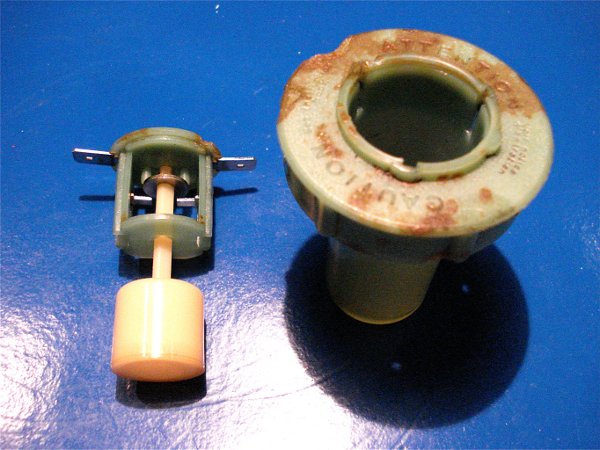|
|
Back to hand brake Forward to driveshaft In principle there are two different kinds of brake fluids, which were used with 2CV's of different years of construction. On the one hand DOT-4-brake fluid (as far as I know only the types with drum brakes in front and in the back) and on the other hand LHM (with the models with disc brakes in front). DOT-4 is a liquid with a boiling point of 230 degrees Celsius, insisting on Glycol base. The high boiling point is necessary, so that with the brake applications no steam bubbles form in the brake system. Breaking means to convert kinetic energy into heat energy by friction. With racing cars you can see glowing brake disks shining through the rims. Steam bubbles, caused by heat transmission of the brake drums or - disks, can be squeezed together substantially more easily than liquids and that means that the brake pressure suddenly disappears, if a part of the brake fluid begins to simmer. Glycol possesses however still another useful characteristic - it dissolves water. Water drops near the brakes would simmer with 100 degrees Celsius, much earlier than fresh Dot-4. In addition free water in the lines promotes the corrosion, which is prevented likewise by glycol. The mixture of water and Dot-4 brake fluid however has a lower boiling point, why this must be changed occasionally (approx. every 2 years). LHM is a hydraulic oil not mixable with water. The advantage is that the boiling point is not lowered by penetrating water (air humidity). It has an unfavorable effect that water, if it finds nevertheless a way into the brake circuit remains as drops somewhere. Since the density of water is larger than those from LHM these drops accumulate at the lowest points of the brake system and remain there. A larger drop in the system can evaporate with longer downhill passages with continuous braking due to the heat with the consequences already described above. LHM is no more used therefore with new cars and is therefore not available in each store. Citroen garages always have LHM - thus buys best there. The two brake fluids are not mixable! DOT liquid instead of LHM or in reverse also only in smallest quantities destroys the entire brake assembly! Brake assemblies for LHM possess a green cap on the brake fluid container and green items on the brake calipers of the disc brakes. LHM is likewise a green liquid.  After the installation of the new brake tubes they are to be filled now with the CORRECT brake fluid. With the ventilation of the brake assembly it must be prevented that you push the brake pedal down to the floor plate! A rubber in the master brake cylinder can invert itself and thus this unit will be destroyed. For this reason I put a polystyrene block with a metal plate under the brake pedal, so that only short pumping movements can be done. Now fill the brake fluid container up to the maximum an then briefly loosen the two brake tubes until some brake fluid withdraws here (otherwise you'll only pump air). Now tighten the brake tubes again. You must begin with filling and ventilation in the most distant place of the line system, thus at the drum brake right in the back. Here the exhaust ventil must be opened (all other vent screws close). Now call for an aid, that pumps at the brake pedal slowly, until brake fluid NONPOROUS (thus not bubbling) withdraws by the vent screw. Close this now and continue with the exhaust at the left rear wheel. At the end the front brake circuit (there is only the exhaust on the driver's side here) is filled. After one hour I did the whole procedure again at all screws, in order to be sure that no more air remained in the lines or pistons. Fill the brake fluid container again up to the marking MAX. A level of liquid somewhere between MIN and MAX is not sufficient! After removing the polystyrene block the brake pedal may only pump a short way and should not not be 'soft', otherwise somewhere is still air in the system and the procedure must be repeated! I have bought 1L LHM and there is still enough fluid left.  The switch detecting a too low level of braking fluid consists out of a floater and two metal contacts. Thanks to Rolf for the picture. Back to hand brake Forward to driveshaft |